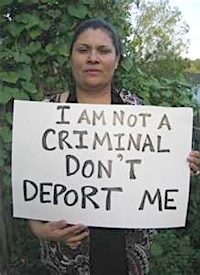
President Obama’s efforts to tighten the leash on U.S. immigration enforcement have caused a sharp drop in the number of deportations, according to a report by the Syracuse University Transactional Records Access Clearinghouse. In the last three months of 2011, following the administration’s directive to curb deportations of illegal immigrants without criminal records or who came to the United States as a child or student (among other discretionary factors), deportations have plummeted.
The number of deportation proceedings instituted from October to December 2011 by Immigration and Customs Enforcement (ICE) plunged to 39,331, a 33-percent decline from the 58,639 filings documented the previous quarter. “Filings are typically lower at this time of year, but even adjusting for this seasonal drop-off and for late reporting,” the report noted, “there appear to have been over 10,000 fewer deportation filings than would have been expected last quarter.”
The chief priority of the administration’s June 17, 2011 directive was to restrict most deportations to those immigrants with criminal records. “It makes no sense to spend our enforcement resources on these low-priority cases when they could be used with more impact on others, including individuals who have been convicted of serious crimes,” Cecilia Muñoz, Director of Intergovernmental Affairs, wrote last August in a White House blog post. “This means more immigration enforcement pressure where it counts the most, and less where it doesn’t,” she added. “That’s the smartest way to follow the law while we stay focused on working with the Congress to fix it.”
However, according to Syracuse University researchers, there is “little evidence” that immigrants with criminal records are representing a higher ratio of overall deportations. In fact, during the purported timeframe, only 1,300, or 3.3 percent, were to be deported as alleged “aggravated felons.” Conversely, from July to September 2011, 3.8 percent were alleged “aggravated felons,” while six months ago the proportion was 4 percent. The researchers added:
An additional 4,193 were charged by ICE for other alleged criminal activity last quarter. When considered together with alleged “aggravated felons,” the proportion of filings in the last quarter seeking deportation on grounds of any alleged criminal activity was still less than one out of seven (14%). And even this small slice is continuing to decline. Two years ago, slightly more than one of six (17.3 percent) were alleged to have engaged in criminal activity as the grounds ICE cited for seeking removal.
“People have heard about these policy changes but largely haven’t seen any difference,” asserted Frank Sharry, executive director of immigration advocacy group America’s Voice.
Many critics have alleged that President Obama’s June 2011 directive was largely political, particularly considering deportations have reached record levels, averaging 400,000 per year, under the current administration. Astoundingly, that’s double the annual average during President Bush’s first term and 30 percent higher than the average when Bush left office. Due to those record numbers, along with Obama’s failure to implement so-called “comprehensive immigration reform,” there has been an ignition of criticism among the Hispanic community — a growing portion of the Democratic voter base.
“Latino immigrant voters know that the Alabama and Arizona laws didn’t come about from Democrats. They’re aware the Obama administration is fighting those laws. They know that Republicans blocked the DREAM Act. They know that Mitt Romney is talking about massive self-deportation,” Sharry said. “And they’re angry and disappointed that the Obama administration promised a legislative breakthrough, didn’t deliver it, but has delivered on record deportations.”
In response, the President has embarked on a political campaign to recover previous support from this pivotal sector of the American electorate.
“What we’ve been able to do is, administratively, we’ve said — let’s reemphasize our focus when it comes to enforcement on criminals and at the borders, and let’s not be focusing our attention on hard-working families who are just trying to make ends meet,” Obama said in an interview last week. “We’ve administratively proposed to reform the ‘three and 10″ program so that families aren’t separated when they’re applying to stay here in this country.”
In emphasizing his newly coined “five more years” campaign slogan, the President assured a Hispanic audience that he would use his second term to push immigration reform. “My presidency is not over,” Obama indicated, responding to a question about his failure to actualize an immigration bill. “I’ve got another five years coming up. We’re going to get this done.”
Moreover, the President rejected the notion that he broke a campaign promise, while passing the blame to Republicans who were unwilling to embrace any “sensible solutions” on the issue. “So far, we haven’t seen any of the Republican candidates even support immigration reform,” Obama charged, targeting his potential opponents in the upcoming presidential contest.
Political analysts and commentators have predicted that the Hispanic vote will be critical for Obama’s reelection bid, as the minority’s rising population has become an increasingly chief component of the American electorate. While many Hispanics who supported Obama in 2008 may refrain from voting Republican, their disappointment over Obama’s immigration efforts may deter them from even voting at all come November 6.
Considering the persistently stale economy — which has led to a sharp drop in Obama’s approval ratings — the President will rely heavily on minority voting groups, observers predict. As the Los Angeles Times reported last October, the President has commenced an “all-out push to rebuild his popularity” with Hispanics, which has been “diminished by the weak economy and a lack of progress toward revamping the nation’s immigration system.”
“The excitement isn’t there like it was,” asserted Ana Canales, a volunteer and the county chairwoman for the Democratic Party of Bernalillo County in New Mexico, where the Obama campaign has accelerated efforts to recruit Hispanic voters. “There are a lot of people who are saying, ‘We’re not going to vote.’ We have a lot of work on our hands … to make sure those Latinos understand that he [Obama] is working for us.”



